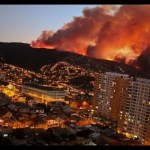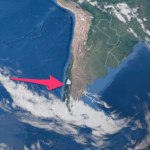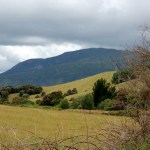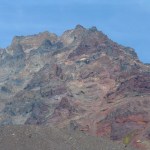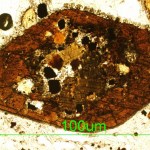Chile
There have been significant wildfires in Chile since November, and they continue. These are the worst fires Chile has seen in known history, and Chile has been keeping track of its history for quite a while.
Are these fires climate change caused? Apparently so. Chile has had a rain deficit for well over a decade, though it as been extra dry for about five years. Drought experts call it a "mega-drought." Droughts tend to have climate change links, and this one is no exception. A study from just one year ago links anthropogenic climate change to the drought.
Within large uncertainties in…
Calbuco is a volcano in southern Chile. This one erupts fairly frequently averaging about every 20 years, sometimes quite impresively. The largest eruption during historic times in Chile occurred at Calbuco in 1894.
It is erupting now. Evacuations have been ordered. Here is some amazing footage:
Back in August, events and exhibits marked the one-year anniversary of learning that 33 miners who were trapped underground in Chile's San Jose mine were alive. The rescue, which involved drilling a 2,000 foot shaft and lifting out the miners who'd endured 69 days underground, captivated viewers around the world.
The New York Times' Alexei Barrionuevo takes a look at how the miners have fared since their rescue, and reports that the trauma of being trapped underground continues to afflict many of them. Their situations are not what one might expect for international celebrities:
One year…
Last week, I was fortunate to be able to attend the opening of a Smithsonian Museum of Natural History exhibit dedicated to the rescue of 33 miners from the San José mine in Chile, and meet two of miners whose story captivated the world as they endured 69 days underground following a mine explosion. Carlos Barrios, Jorge Galleguillos, José HenrÃquez, and Mario Sepúlveda traveled to DC for the opening of "Against All Odds: Rescue at the Chilean Mine," a small but powerful exhibit whose centerpiece is one of the capsules built to haul the miners up 2,000 feet through the narrow shaft drilled…
After last week's triumphant rescue of 33 miners from Chile's San José mine, attention has turned to mine safety in Chile and worldwide.
The Associated Press reports that President Sebastian Piñera fired the top regulators from Chile's mine safety agency and promised to triple its budget. In the weeks following the San José collapse, at least 18 small mines were shut down for safety violations. Piñera has promised that in the coming days he'll unveil a proposal for more effectively protecting Chilean workers, and a commission is investigating the San José disaster and will recommend…
All 33 of the miners who were trapped in Chile's San José mine have been safely lifted to the surface, as have the six rescuers who descended into the mine during the operation. Shift supervisor Luis Urzua was the last miner lifted to safety in the specially designed capsule that traversed the more than 2,000 feet between the miners' refuge and the surface.
The miners' survival for 69 days underground and their triumphant rescue is a story of fortitude, ingenuity, and teamwork. Chileans have much to be proud of and celebrate today. Audiences around the world have been watching the rescue…
Sixty-nine days after an explosion trapped 33 miners 2,000 feet underground in the San José copper and gold mine in Copiapó, Chile, rescuers have begun lifting miners to the surface. As of 6am this morning, eight miners have been pulled to safety: Florencio Avalos, Mario Sepulveda, Juan Illanes, Carlos Mamani, Jimmy Sanchez, Osman Araya, José Ojeda, and Claudio Yañez.
The Associated Press explains that a specially constructed "Phoenix" capsule is raised and lowered, bringing one miner at a time through a 28-inch diameter hole. Each miner is equipped with an oxygen tank, communications…
Finally, a chance to catch up a bit ... !
Yasur erupting in May of 2010.
Some news from the world of volcanoes:
The BBC has a series of videos one the fallout from the Eyjafjallajökull eruption - including a look at the area around the volcano and how the economy has been affected by the eruption. However, things seem pretty quiet at the summit of the Eyjafjallajökull summit where snow can begun to settle without melting - and the Icelandic Met Office appears to think that the eruption is more or less (but not officially) over. And take this press release as you will, but a recent study…
An August 5th collapse at the San Jose gold and copper mine in Chile's Atacama region trapped 33 miners hundreds of meters underground. Rescue teams had been drilling toward a refuge site, where it was hoped the miners had been able to take shelter - and earlier today, a probe sent down into the mine came back with a note saying "all 33 of us are fine in the shelter."
Chileans have flocked to plazas to celebrate, and the newspaper La Tercera compares it to the delight that greeted Chile's World Cup wins. After 17 anxious days of waiting for news, the miners' families are overjoyed.
It will…
When we last left MVP, the latest entry actually did give people some trouble - but Don Crain ended up landing the winner at guess #15. The volcano is Ollagüe along the Chilean/Bolivian border. I took this shot from the road that comes up from the south towards Ollagüe (the town). Now, I have been to Ollagüe (the town) in almost 10 years now, but I did stay in a "hotel" called the Hotel Brin Bran - good soup, surly owner, nice view of both Ollagüe (the volcano) and Aucanquilcha. Definitely the vacation spot if you're visiting the high Andean Chilean/Bolivian frontier.
So, our standings:…
The northern Chilean and southern Peruvian Andes are full of volcanoes that look stunning - I mean, jaw-dropping details of volcanism litter the landscape. The reason for this is two fold: (1) there is an awful lot of volcanism in the northern Chilean/southern Peruvian Andes (as known as the Central Volcanic Zone) - and has been that way for over 10 million years and (2) it has also been very, very dry in the area (most of which is known as the Altiplano-Puna Plateau) for at least a few millions years as well - it is the home of the Atacama Desert! So, this means you get lots of volcanic…
So, I've had requests on the blog to help to do some defining of volcanologic terms on the blog, so I thought I'd try a new column called Eruptions Word of the Day. I'm not sure how often it will run, but let's give it a try.
Eruptions Word of the Day for July 5, 2010: Dacite
Dacite is a magma type defined by silica (SiO2) content between 63-68 (or 69) weight percent. That is the textbook definition, but some other typical characteristics of dacite lavas (or magmas) is the presence of certain minerals: plagioclase feldspar and hydrous minerals (containing water in their mineral structure)…
Have guests in town, so I'm a little busy, but you can hopefully keep entertained with the latest Smithsonian/USGS Global Volcanism Program Volcanic Activity Report.
Chile's Melimoyu volcano.
The highlights (not including Taal and Eyjafjallajökull) include:
Alaska's Cleveland volcano has been reduced to and alert status of "unassigned" (used when a volcano is not closely monitored so AVO doesn't know what exactly is "background") after a few weeks of activity. The same was done for the submarine volcano south of Sarigan in the Marianas Islands after no signs of activity since the eruption…
The latest Weekly Volcanic Activity Report from our friends at the Smithsonian Global Volcanism Program and the USGS.
Highlights (not including Eyjafjallajökull - you can check the latest IMO update on that eruption and the latest VAAC ash advisories.):
Villarrica in Chile was raised from Alert Level 1 to 2 by the Chilean SERNAGEOMIN after an increase in seismicity, a rise in the lava lake levels at the summit and more vigorous fumarolic activity.
In the first update in a while, a small ash plume was noticed at Chaiten in Chile, rising to ~1.8 km (8,000 feet) from the new domes.
Karymsky in…
Time to play a little catch up ...
Eyjafjallajökull erupting in early May. Image by and courtesy of Martin Rietze.
A brief update on our friend Eyjafjallajökull - the eruption plume from the volcano was considerably taller yesterday, reaching 6-9 km (20,000-30,000 feet), but prevailing winds meant the ash hazard was confined to areas in the middle of the North Atlantic and northern parts of the British Isles. However, even as the ash hazard for Europe wanes (for now), you shouldn't forget the amount of ash being dumped on parts of Iceland. If you want to see some stunning images of the…
Chaiten in Chile erupting on May 5, 2008, four days after the volcano came back to life after ~9,000 years of dormancy.
Quick post ... but until I was reminded by Eruptions reader Guillermo, I had forgotten two important anniversaries.
First, today (May 1) marks the 2nd anniversary of the start of the Chaiten eruption in Chile. The eruption is still rumbling along (spanish), with growth of three domes in the Chaiten caldera. I'll have more to say about this on Monday.
Secondly, today also marks the second anniversary for the start of this blog! Yes, if you can believe it, Eruptions turns two…
Gaua erupting in February 2010. Image courtesy of the NASA Earth Observatory.
As a certain famous Icelandic native would say, "there is more to life than this."
Some other volcano news from around the world:
The situation at Gaua in Vanuatu is worsening. Ash from the current eruption is contaminating water and food supplies on the island. Authorities are planning on evacuating 3,000 people from the island if the eruption that started in 2009 gets worse, but there has already been significant ash fall, mudflows and explosions.
Shiveluch on the Kamchatka Peninsula in eastern Russia continues…
Actually, no the volcanoes aren't from space, but pictures of the volcanoes were taken from space. The NASA Earth Observatory has posted three more gems of volcanic activity taken by one of the fleet of earth imagers in orbit:
A recent image of Chaiten taken by EO-1. Image courtesy of the NASA Earth Observatory.
There is a great image of the busy Kamchatkan Peninsula, where four volcanoes are seen erupting in a single image - Kliuchevskoi, Bezymianny, Shiveluch and Karymsky. The plume from Karymsky is especially prominent as a grey streak above the white snow of the Russian winter (albeit…
As a volcanologist, I am partial to impressive lava flows, especially in volcanoes that erupt material that you'd think wouldn't produce big flows. For example, there are quite a few volcanoes in the Chilean Andes that erupt dacite lavas, which are relatively viscous (sticky), so you might expect it to erupt explosively. However, you can get large dacitic to rhyolitic lava flows, quite commonly, and these large flows are called coulées (a "volcanic dome flow").
Lllullaillaco volcano on the Chile/Argentina border. Note the very prominent coulée with flow levees. Click on the image to see a…
Alan Boyle, Science Editor for MSNBC.com, was kind enough to answer questions about science in the mainstream media after the fallout of the coverage of the Chilean earthquake.
Alan Boyle, science editor for MSNBC.com
Alan has been with MSNBC.com since 1996, covering science and technology. He has his own blog on space called the Cosmic Log. He's also won quite the array of awards including from the National Academies, the American Association for the Advancement of Science, the National Association of Science Writers, the Society of Professional Journalists, the Space Frontier Foundation,…
